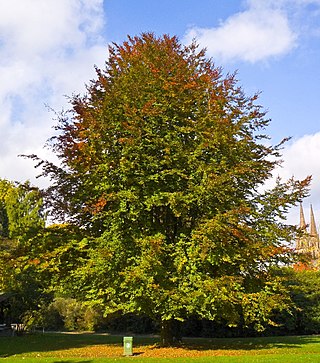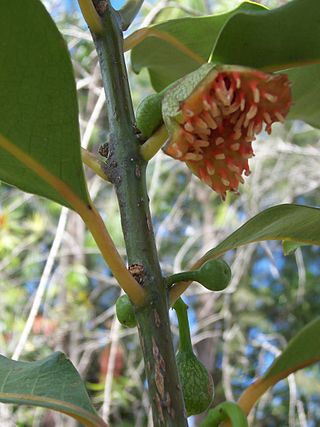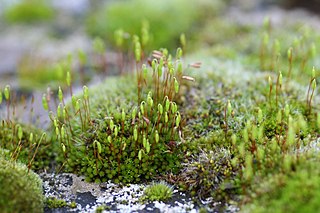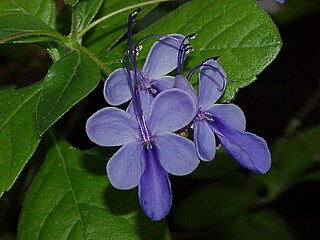
Over 1,000 species were accepted in the moss genus Bryum [1] [2] until it was split into three genera in a 2005 publication. [3] As of 2024 [update] , the genus has 281 accepted species, 220 synonyms, and 2 unplaced. [2]

Over 1,000 species were accepted in the moss genus Bryum [1] [2] until it was split into three genera in a 2005 publication. [3] As of 2024 [update] , the genus has 281 accepted species, 220 synonyms, and 2 unplaced. [2]
Bryum acuminatissimum - Bryum acutifolium - Bryum afrocalophyllum - Bryum alandense - Bryum albomarginatum - Bryum albopulvinatum - Bryum albulum - Bryum altaicum - Bryum amblyacis - Bryum amentirameum - Bryum anomodon - Bryum apalodictyoides - Bryum arachnoideum - Bryum argenteum - Bryum argentisetum - Bryum atrovirens - Bryum auratum - Bryum austroturbinatum
Bryum baeuerlenii - Bryum bavaricum - Bryum bharatiense - Bryum billetii - Bryum blindii - Bryum borellii - Bryum botterii - Bryum bourgeanum - Bryum brachycladulum - Bryum brasiliense - Bryum brevicoma - Bryum bulbiferum - Bryum bulbigerum - Bryum bulbillicaule - Bryum bullosum
Bryum cadetii - Bryum calobryoides - Bryum campoanum - Bryum campylopodioides - Bryum capillatum - Bryum capituliforme - Bryum carbonicola - Bryum challaense - Bryum cognatum - Bryum colombi - Bryum coloradense - Bryum conoideo-operculatum - Bryum crassimucronatum - Bryum crassinervum - Bryum cremocarpum - Bryum cristatum - Bryum crozetense
Bryum deciduum - Bryum defractum - Bryum delitescens - Bryum denticulatinervium - Bryum depressum - Bryum diaphanum - Bryum dillenii - Bryum dimorphum - Bryum dissolutinerve - Bryum dixonii - Bryum dolichophyllum - Bryum dongolense - Bryum dyffrynense
Bryum ekmanii - Bryum elegantulum - Bryum ellipsifolium - Bryum ellipticifolium - Bryum elwendicum - Bryum encalyptaceum - Bryum erectum - Bryum erythrotropis - Bryum euryphyllum - Bryum evanidinerve
Bryum fabronia - Bryum felipponei - Bryum flaccidifolium - Bryum flagellans - Bryum flagellicoma - Bryum flavipes - Bryum flavopallidum - Bryum formosum - Bryum francii - Bryum funckiioides - Bryum fuscescens - Bryum fuscomucronatum - Bryum fuscotomentosum
Bryum gamophyllum - Bryum garovaglii - Bryum gemmatum - Bryum germainii - Bryum gilliesii - Bryum gjaidsteinense - Bryum glaciale - Bryum glacierum - Bryum gracilisetum - Bryum gynostomoides - Bryum gyoerffianum
Bryum haematoneurum - Bryum harriotii - Bryum hatcheri - Bryum hauthalii - Bryum hedbergii - Bryum heterophyllum - Bryum hioramii
Bryum illecebraria - Bryum imbricatum - Bryum innovans - Bryum insolitum
Bryum kashmirense - Bryum kikuyuense - Bryum kilimandscharicum
Bryum lamii - Bryum lamprocarpum - Bryum lamprocomum - Bryum lamprostegum - Bryum lanatum - Bryum latilimbatum - Bryum leoni - Bryum lepidum - Bryum leptocaulon - Bryum leptoglyphondon - Bryum leptospeiron - Bryum leptotorquescens - Bryum leptotrichum - Bryum leucoglyphodon - Bryum leucophylloides - Bryum liliputanum - Bryum limbifolium - Bryum lonchophyllum - Bryum lonchopus - Bryum lorentzii - Bryum ludovicae - Bryum lugubre - Bryum luteolum
Bryum macroblastum - Bryum macrodictyum - Bryum mairei - Bryum megalacrion - Bryum mendax - Bryum mesodon - Bryum microcapillare - Bryum microcochleare - Bryum microimbricatum - Bryum micronitidum - Bryum mieheanum - Bryum minusculum - Bryum minutirosatum - Bryum minutissimum - Bryum mirabile - Bryum miserum - Bryum mollifolium - Bryum molliusculum - Bryum mucronifolium - Bryum multiflorum
Bryum nanocapillare - Bryum nanophyllum - Bryum neelgheriense
Bryum oamaruanum - Bryum obliquum - Bryum oblongum - Bryum obscurum - Bryum ochianum - Bryum oedeneuron - Bryum oncophorum - Bryum oophyllum - Bryum orthocladum - Bryum orthodontioides - Bryum osculatianum - Bryum oxycarpum
Bryum pabstianum - Bryum pallidisetum - Bryum pallidoviride - Bryum pamirense - Bryum pamiricomucronatum - Bryum pancheri - Bryum papuanum - Bryum paraguense - Bryum parvulum - Bryum patzeltii - Bryum pedemontanum - Bryum peralatum - Bryum perdecurrens - Bryum perminutum - Bryum perrieri - Bryum petelotii - Bryum phallus - Bryum platense - Bryum platyphyllum - Bryum pocsii - Bryum posthumum - Bryum procerum - Bryum prosatherum - Bryum pseudoblandum - Bryum pseudomicron - Bryum pseudopachytheca - Bryum pungentifolium - Bryum purpuratum - Bryum purpureolucidum - Bryum purpureonigrum - Bryum pycnodictyum - Bryum pygmaeomucronatum - Bryum pygmaeum - Bryum pyrrhothrix
Bryum rapaense - Bryum rectifolium - Bryum recurvulum - Bryum redboonii - Bryum remelei - Bryum retusifolium - Bryum rhexodon - Bryum rhizoblastum - Bryum rhypariocaulon - Bryum richardsii - Bryum riparioides - Bryum riparium - Bryum rivale - Bryum roscheri - Bryum rosulans - Bryum rubescens - Bryum rubicundum - Bryum rubrocostatum - Bryum rudimentale - Bryum rufolimbatum - Bryum runmaroeense - Bryum russulum
Bryum sabuletorum - Bryum salakense - Bryum sandii - Bryum savesii - Bryum savondroninicus - Bryum schmidtii - Bryum sclerodictyon - Bryum semirubrum - Bryum serpillifolium - Bryum sinense - Bryum sinuosum - Bryum skottsbergii - Bryum soboliferum - Bryum sordidum - Bryum spinifolium - Bryum spinosum - Bryum splachnobryoides - Bryum splendidifolium - Bryum srilankenese - Bryum stellituber - Bryum stenophyllum - Bryum subargenteum - Bryum subclavatum - Bryum subgracillimum - Bryum subleucophyllum - Bryum subpercurrente - Bryum subprostatum - Bryum subrotundifolium - Bryum svihlae
Bryum taimyrense - Bryum taitae - Bryum taoense - Bryum tenerum - Bryum tenuidens - Bryum tepintzensa - Bryum terskeiense - Bryum thomeanum - Bryum tisserantii - Bryum tjiburrumense - Bryum torquatum - Bryum trabutii
Bryum vernum - Bryum veronense - Bryum viguieri - Bryum vitianum - Bryum voeltzkowii - Bryum vulcanicum

Apiaceae or Umbelliferae is a family of mostly aromatic flowering plants named after the type genus Apium and commonly known as the celery, carrot or parsley family, or simply as umbellifers. It is the 16th-largest family of flowering plants, with more than 3,800 species in about 446 genera, including such well-known and economically important plants as ajwain, angelica, anise, asafoetida, caraway, carrot, celery, chervil, coriander, cumin, dill, fennel, lovage, cow parsley, parsley, parsnip and sea holly, as well as silphium, a plant whose exact identity is unclear and which may be extinct.

The Polygonaceae are a family of flowering plants known informally as the knotweed family or smartweed—buckwheat family in the United States. The name is based on the genus Polygonum, and was first used by Antoine Laurent de Jussieu in 1789 in his book, Genera Plantarum. The name may refer to the many swollen nodes the stems of some species have, being derived from Greek [poly meaning 'many' and gony meaning 'knee' or 'joint']. Alternatively, it may have a different origin, meaning 'many seeds'.

Genus is a taxonomic rank above species and below family as used in the biological classification of living and fossil organisms as well as viruses. In binomial nomenclature, the genus name forms the first part of the binomial species name for each species within the genus.

Tabebuia is a genus of flowering plants in the family Bignoniaceae. Tabebuia consists almost entirely of trees, but a few are often large shrubs. A few species produce timber, but the genus is mostly known for those that are cultivated as flowering trees.

The Fagaceae are a family of flowering plants that includes beeches, chestnuts and oaks, and comprises eight genera with about 927 species. Fagaceae in temperate regions are mostly deciduous, whereas in the tropics, many species occur as evergreen trees and shrubs. They are characterized by alternate simple leaves with pinnate venation, unisexual flowers in the form of catkins, and fruit in the form of cup-like (cupule) nuts. Their leaves are often lobed, and both petioles and stipules are generally present. Their fruits lack endosperm and lie in a scaly or spiny husk that may or may not enclose the entire nut, which may consist of one to seven seeds. In the oaks, genus Quercus, the fruit is a non-valved nut called an acorn. The husk of the acorn in most oaks only forms a cup in which the nut sits. Other members of the family have fully enclosed nuts. Fagaceae is one of the most ecologically important woody plant families in the Northern Hemisphere, as oaks form the backbone of temperate forest in North America, Europe, and Asia, and are one of the most significant sources of wildlife food.

The Scrophulariaceae are a family of flowering plants, commonly known as the figwort family. The plants are annual and perennial herbs, as well as shrubs. Flowers have bilateral (zygomorphic) or rarely radial (actinomorphic) symmetry. The Scrophulariaceae have a cosmopolitan distribution, with the majority found in temperate areas, including tropical mountains. The family name is based on the name of the included genus Scrophularia L.

Bignoniaceae is a family of flowering plants in the order Lamiales commonly known as the bignonias or trumpet vines. It is not known to which of the other families in the order it is most closely related.

Antirrhinum is a genus of plants commonly known as dragon flowers or snapdragons because of the flowers' fancied resemblance to the face of a dragon that opens and closes its mouth when laterally squeezed. They are also sometimes called toadflax or dog flower. They are native to rocky areas of Europe, the United States, Canada, and North Africa. Antirrhinum species are widely used as ornamental plants in borders and as cut flowers.

Plantaginaceae, the plantain family, is a large, diverse family of flowering plants in the order Lamiales that includes common flowers such as snapdragon and foxglove. It is unrelated to the banana-like fruit also called "plantain." In older classifications, Plantaginaceae was the only family of the order Plantaginales, but numerous phylogenetic studies, summarized by the Angiosperm Phylogeny Group, have demonstrated that this taxon should be included within Lamiales.

The Monimiaceae is a family of flowering plants in the magnoliid order Laurales. It is closely related to the families Hernandiaceae and Lauraceae. It consists of shrubs, small trees, and a few lianas of the tropics and subtropics, mostly in the southern hemisphere. The largest center of diversity is New Guinea, with about 75 species. Lesser centres of diversity are Madagascar, Australia, and the neotropics. Africa has one species, Xymalos monospora, as does Southern Chile. Several species are distributed through Malesia and the southwest Pacific.

Rebutia is a genus of flowering plants in the family Cactaceae, native to Bolivia and Argentina. They are generally small, colorful cacti, globular in form, which freely produce flowers that are relatively large in relation to the body. They have no distinctive ribs, but do have regularly arranged small tubercles. They are considered fairly easy to grow and they may produce large quantities of seeds that germinate freely around the parent plant.

Attalea is a large genus of palms native to Mexico, the Caribbean, Central and South America. This pinnately-leaved, non-spiny genus includes both small palms lacking an aboveground stem and large trees. The genus has a complicated taxonomic history, and has often been split into four or five genera based on differences in the male flowers. Since the genera can only be distinguished on the basis of their male flowers, the existence of intermediate flower types and the existence of hybrids between different genera has been used as an argument for keeping them all in the same genus. This has been supported by recent molecular phylogenies.

Bryaceae is a family of mosses.

The flora of Australia comprises a vast assemblage of plant species estimated to over 21,000 vascular and 14,000 non-vascular plants, 250,000 species of fungi and over 3,000 lichens. The flora has strong affinities with the flora of Gondwana, and below the family level has a highly endemic angiosperm flora whose diversity was shaped by the effects of continental drift and climate change since the Cretaceous. Prominent features of the Australian flora are adaptations to aridity and fire which include scleromorphy and serotiny. These adaptations are common in species from the large and well-known families Proteaceae (Banksia), Myrtaceae, and Fabaceae.

Rotheca is a genus of flowering plants in the family Lamiaceae. Estimates of the number of species in the genus vary from about 35 to as many as 60. Three of the species are native to tropical Asia, with the rest occurring in Sub-Saharan Africa. The type species for the genus is Rotheca serrata. It had originally been named Rotheca ternifolia, but this name is now considered illegitimate.

Bryum is a genus of mosses in the family Bryaceae. It was considered the largest genus of mosses, in terms of the number of species, until it was split into three separate genera in a 2005 publication. As of 2013, the classification of both Bryum and the family Bryaceae to which it belongs underwent significant changes based on DNA studies.

The Solanaceae, or the nightshades, are a family of flowering plants that ranges from annual and perennial herbs to vines, lianas, epiphytes, shrubs, and trees, and includes a number of agricultural crops, medicinal plants, spices, weeds, and ornamentals. Many members of the family contain potent alkaloids, and some are highly toxic, but many—including tomatoes, potatoes, eggplant, bell and chili peppers—are used as food. The family belongs to the order Solanales, in the asterid group and class Magnoliopsida (dicotyledons). The Solanaceae consists of about 98 genera and some 2,700 species, with a great diversity of habitats, morphology and ecology.
James Stirton was a Scottish physician and one of Scotland's leading experts on cryptogamic botany. His investigations in bryology and lichenology earned him a world-wide reputation.
Gemmabryum is a species of moss in the family Bryaceae. It was separated from the genera Bryum and Brachymenium in 2005. It has been argued that the correct name for the genus is Osculatia.